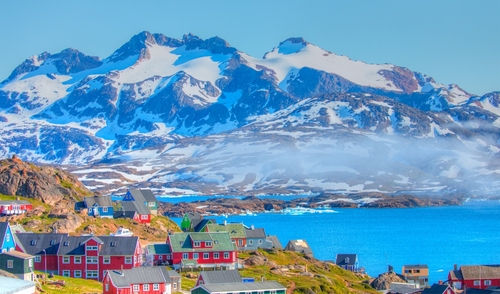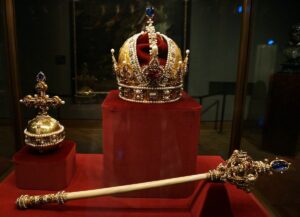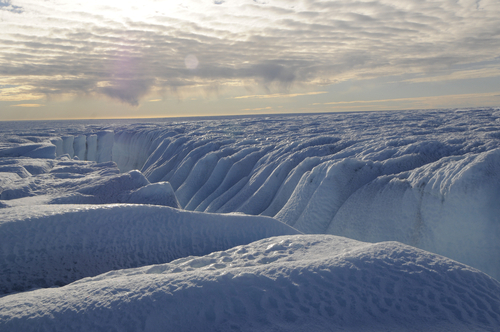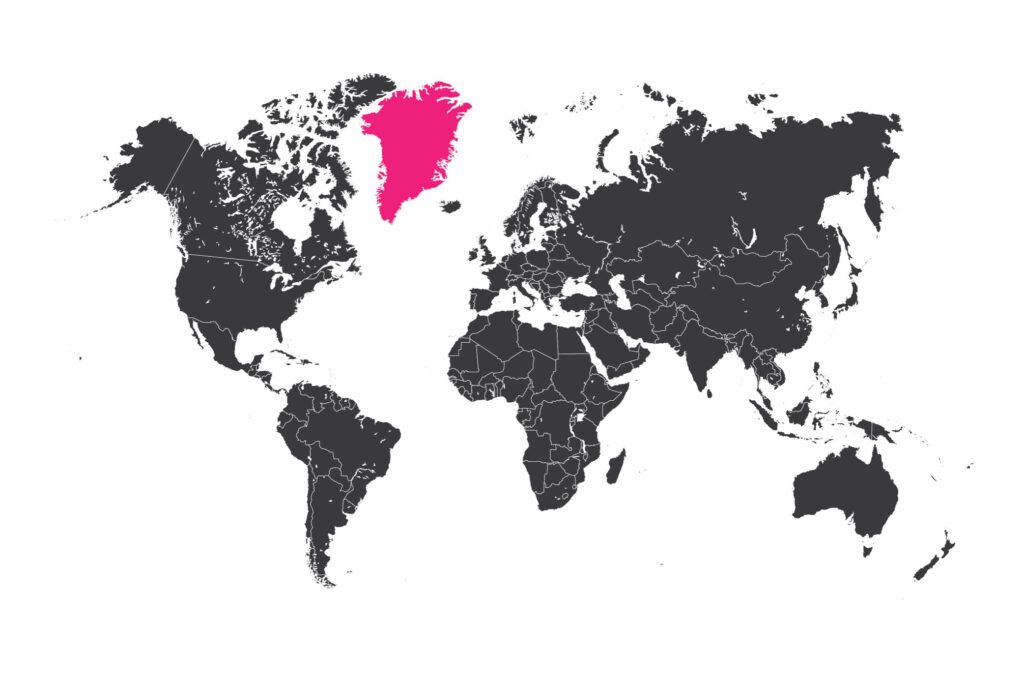Greenland
Grades 7+
 The year is 982. A Viking longship, led by Erik the Red, so called because of his red hair and beard, plows through the North Atlantic. It runs low in the water, its belowdecks filled with equipment and food for life in a new land. The crew of slaves and sailors, sitting on chests that hold their possessions and more cargo, bend their backs into the rowing, soaked to the skin with freezing water. Above them, the sail snaps in the wind.
The year is 982. A Viking longship, led by Erik the Red, so called because of his red hair and beard, plows through the North Atlantic. It runs low in the water, its belowdecks filled with equipment and food for life in a new land. The crew of slaves and sailors, sitting on chests that hold their possessions and more cargo, bend their backs into the rowing, soaked to the skin with freezing water. Above them, the sail snaps in the wind.
The helmsman, at the stern of the boat, mans the ship’s rudder. It is a long, narrow, light, wooden vessel, its arched bow graced with a serpent’s head that causes some Viking enemies to call the ship a dragon boat.
Erik also stands at the stern, along with his wife, Thjódhild Jorundsdottir. He is a violent man, but it is a culture that needs and admires warriors, so a capacity for violence is to be expected. His father had been exiled to Iceland because he killed two men in Norway. Now, Erik has killed Eyjolf the Foul for murdering two of Erik’s slaves. Erik is exiled for three years from Iceland. Going back before then will mean death.
When at last he reaches the new country, Erik finds a land almost completely covered with an enormous ice shelf, it walls higher than those of a mighty fortress. What little ice-free land remains is snow-covered much of the year. Still, along the coast, there is a fringe of willow, spruce, and juniper trees.
The Vikings settle in, and after three years Erik returns to Iceland. He calls the new land Greenland to attract settlers. Twenty-five boats set sail for Greenland. Eleven are lost at sea.
Eventually, Leif Ericsson – Erik and Thjódhild’s son (who will become the first European known to reach North America) – returns to Norway. When he comes back, he brings a priest. Leif has converted to Christianity. Thjódhild becomes one of the first converts in Greenland. At her request, Erik builds her a church yet refuses to convert. According to legend, she says he can no longer share a bed with him unless he too becomes Christian. But Erik dislikes a religion that says we should turn the other cheek and that we should love our neighbors. He is a farmer now, but he was raised in a culture that prides itself on the rape and pillaging of people in other countries, especially communities in what is now England and France. He therefore refuses to give up his Norse gods.
♦

Another group of settlers bring a plague, and Erik dies. The settlement he founded lasts almost five hundred years. They people survive by farming and by selling walrus and narwhal tusks to wealthy Europeans. The narwhal becomes associated with the unicorn. The emperor of the Holy Roman Empire uses one as a scepter – the rod that symbolizes his power. Its ends are ornamented with pearls and semi-precious stones.
The settlement eventually dies out and disappears. What happened to the people is not known. We do know that the Vikings cut all the trees in the area for fuel. Then the climate changed, as the climate of the world always does. A minor ice age seized the world. New trees did not grow. To make matters worse, the Vikings’ cattle, goats, and other farm animals ate most of the grass in the region, and the settlers cut turf so they could build houses.
The final cause of the Vikings’ demise in Greenland, though, probably was warfare. When the indigenous population ultimately made their way to where the Vikings lived, the fierce Norsemen ironically could not protect themselves. Lacking firewood, they could no longer make iron weapons.
At the time, there are 3000 Vikings in Greenland– but many Inuit. The Native people call the land Kalaallit Nunaat – the land of humans. It is the largest island in the world.
Its tallest mountain, Uummannaq rises over 3800 feet. The Inuit believed the mountain is magical, that it had a heart that really beat. They insisted they owed everything to it. Every movement of nature, every snowstorm, every icefall had something to do with the mountain.
 Gigantic ice sheets cover eighty percent of the island. Only one-fifth of it is habitable. The Inuit knew how to make do with scarce resources. They collected driftwood and combined it with animal skins to make tents and food caches. That was for summertime; during winter they stayed in dark, damp homes built of peat and rocks, with roofs of animal skins held up by whalebone. The little light the houses held came through windows made of walrus intestines. The famous igloos that people associate with the Inuit were only for emergency shelter during hunts.
Gigantic ice sheets cover eighty percent of the island. Only one-fifth of it is habitable. The Inuit knew how to make do with scarce resources. They collected driftwood and combined it with animal skins to make tents and food caches. That was for summertime; during winter they stayed in dark, damp homes built of peat and rocks, with roofs of animal skins held up by whalebone. The little light the houses held came through windows made of walrus intestines. The famous igloos that people associate with the Inuit were only for emergency shelter during hunts.
Today, Greenlanders live in European-style houses. For many years, they painted them so newcomers could easily find their way around. Red buildings signified churches and schools and their personnel Yellow meant hospitals and medical personnel. Green was for mechanics and teleoperations, blue was meant for the fishing industry and its employees, and black was for police stations.
The traditional Intuit way of life began changing when Danish missionaries arrived in the early 1700s. Their mission was to convert the Inuit to Protestantism. Soon after, Greenland became a Danish colony, and the Inuit suffered from imported diseases, from reorganizations of their society, and from control by colonial lords.
 Now, the island attracts tourists, along with a flood of scientists there to study the ice sheet. It is the only one outside Antarctica and is so heavy that it has depressed the land in the center of the island to -980 feet below sea level. Due to global warming, it is melting. If it melts completely, much of Greenland will become a freshwater lake. But that would be only a change. If the Greenland ice sheet melts completely, sea level will rise 23 feet. Most of the world’s coastal cities will be at least partially submerged.
Now, the island attracts tourists, along with a flood of scientists there to study the ice sheet. It is the only one outside Antarctica and is so heavy that it has depressed the land in the center of the island to -980 feet below sea level. Due to global warming, it is melting. If it melts completely, much of Greenland will become a freshwater lake. But that would be only a change. If the Greenland ice sheet melts completely, sea level will rise 23 feet. Most of the world’s coastal cities will be at least partially submerged.
Greenland Activity 1
Determine which of the following are nouns.
Be sure to use the formula:
Noun = The ______________ OR The __________ named ___________.
1. diseases | 4. tallest | 7. eventually | 10. his | 13. submerged |
2. was | 5.Uummannaq | 8. land | 11. they | 14. island |
3. ice | 6. not | 9. longship | 12. missionaries | 15. personnel |